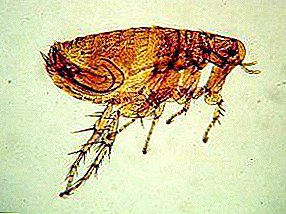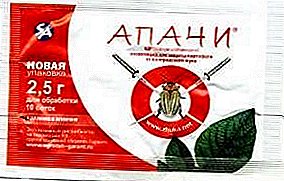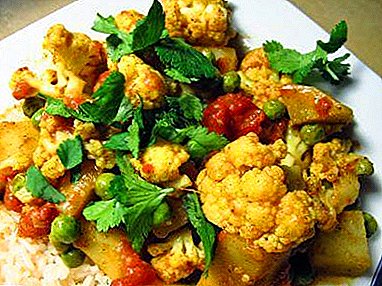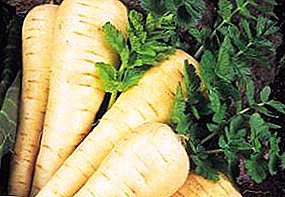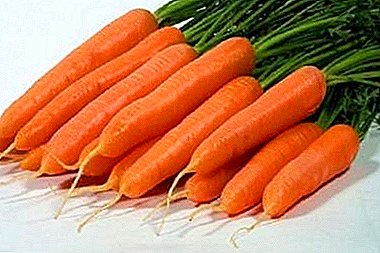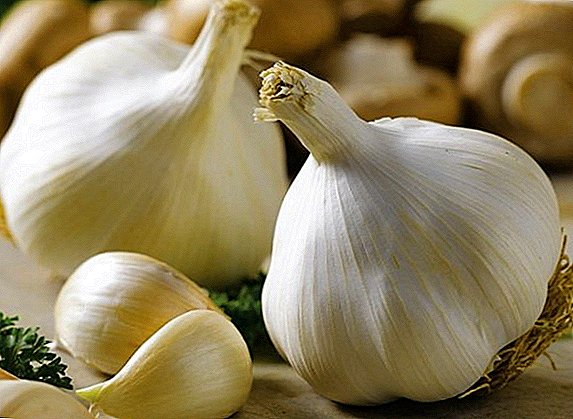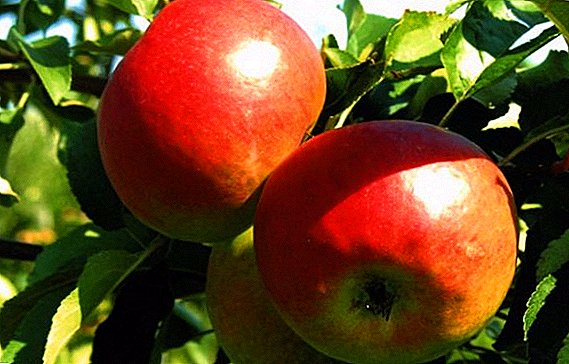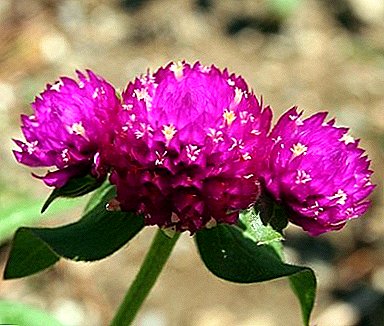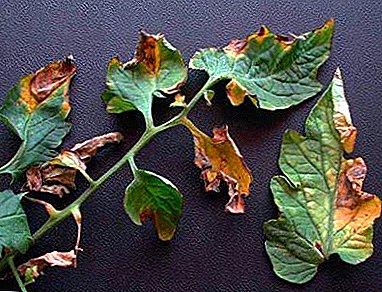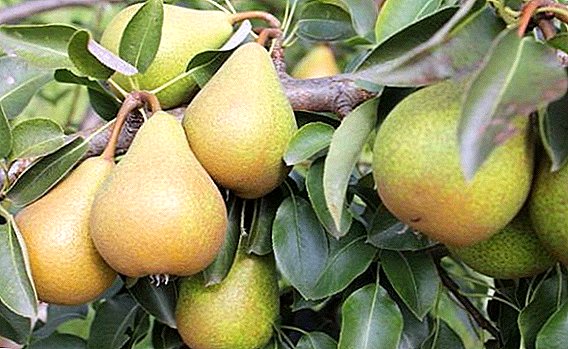 Pear is popular with gardeners because of its tasty and juicy fruit pulp, unpretentiousness in cultivation and a variety of varieties. Today there is a large selection of varieties of different ripening periods that are resistant to diseases and weather conditions - frost resistance, dry periods. On one of the varieties of pears - Kokinskoy talk in this article.
Pear is popular with gardeners because of its tasty and juicy fruit pulp, unpretentiousness in cultivation and a variety of varieties. Today there is a large selection of varieties of different ripening periods that are resistant to diseases and weather conditions - frost resistance, dry periods. On one of the varieties of pears - Kokinskoy talk in this article.
Description varieties of pear Kokinsky
Kokinskaya - pear autumn ripening period, named in honor of the Kokinsky Institute of Horticulture, where it was bred by crossing two varieties: Popular and Cure. The author of the obtained variety is A. A. Vysotsky.
Did you know? In ancient Greece, pears were brought to the temples of Aphrodite and Hera, in Ancient Rome they were dedicated to Juno and Venus. In the mythology of both peoples, these goddesses were a symbol of fertility. During sea voyages with the help of pears alleviated the symptoms of seasickness.
Characteristics of the tree
The height of the Kokinskaya tree is up to four meters, the diameter of the crown is up to three meters. The trunk is straight, slender, the branches diverge from the trunk at an angle. The crown is not too thick, needs pruning, the shape of the crown is pyramidal. Fruiting begins in the fourth year, the yield is high - mature trees yield up to 100 kg of pears.
The variety is winter-hardy, in hard frost when the kidneys freeze, the yield may decrease, but the tree itself does not die. The Kokinska pear variety is described as resistant to diseases such as scab. Less resistant to scab is foliage than fruit. 
Fruit Characteristic
Pears are mounted on a sturdy, thick, steep, long, curved shape. The fruits are painted in a light green color, as they ripen turn yellow, pears, turned to the sun, become covered with a pinkish-red blush. The fruit mass of Kokinska pear reaches 250 grams, the flesh is creamy white, juicy, has a sweet dessert taste with slightly sourness.
The advantages and disadvantages of the variety
The advantages of Kokinska pear include high yield, storage duration in the refrigerator, frost resistance, fruit resistance to diseases and rotting. Fruits of pear have a bright taste and great weight, in addition, the time of ripening pear Kokinsky allow feast on the fruits in September. The fruits are suitable for fresh and for winter harvesting.
Disadvantages: despite the high immunity of the fruit to scab and other diseases, foliage is susceptible to them. There is frost resistance, but during a strong fall in temperature, the kidneys may freeze over, which will affect fruiting.
Landing dates and site selection
 To successfully grow a pear, you need to know everything about the terms, conditions and suitable for Kokinsky pear landing site. Landing dates depend on the climatic conditions of the region. In the northern climate, it is better to plant in the spring in April, in warm weather without night frosts. In regions with early spring, it is better to postpone the procedure to autumn, to September. Hot weather often causes young plants to dry out. Since the plant does not tolerate transplantation, seedlings of Kokinskaya pear should be planted immediately to a permanent place. Pear fit moderately heavy, loose soil with good drainage. It is not desirable close location of groundwater, with the stagnation of moisture, the root system is affected by fungal bacteria. For the tree you need to choose a well-lit, ventilated, but without a draft place. The best is the western, south-western or southern side of the garden.
To successfully grow a pear, you need to know everything about the terms, conditions and suitable for Kokinsky pear landing site. Landing dates depend on the climatic conditions of the region. In the northern climate, it is better to plant in the spring in April, in warm weather without night frosts. In regions with early spring, it is better to postpone the procedure to autumn, to September. Hot weather often causes young plants to dry out. Since the plant does not tolerate transplantation, seedlings of Kokinskaya pear should be planted immediately to a permanent place. Pear fit moderately heavy, loose soil with good drainage. It is not desirable close location of groundwater, with the stagnation of moisture, the root system is affected by fungal bacteria. For the tree you need to choose a well-lit, ventilated, but without a draft place. The best is the western, south-western or southern side of the garden.
Step-by-step process of planting seedlings
According to the rules of agrotechnology for pear Kokinskaya plot for planting is prepared in advance. The plot is dug up, cleaned of weeds and make 10 kg of humus per square meter and 100 g nitrophos. Under the condition of acidic soil dolomite flour is introduced.
Pit for seedlings in the spring is prepared in the fall. Pit size: 70 x 70 meters deep. Drainage is put on the bottom of the pit, from above - a layer of humus or compost up to 20 cm, covered with soil. By the fall planting pit prepared in three weeks. A mixture of soil is prepared from the nutrient layer of soil, peat, humus in equal parts, with the addition of 20 g of phosphorus-potassium fertilizer and 100 g of ash.  For planting pear Kokinsky selected two-year copies of seedlings, with a smooth, evenly colored bark. The branches of a healthy seedling are flexible, the roots are moist and light at the cut. Before the procedure, the roots are immersed in a stimulating solution for a day. After shortening the roots to 10 cm, and the side shoots are cut. The height of the central trunk of a good sapling is up to 85 cm. The sapling is lowered into the hole, straightened the roots and sprinkled with soil, slightly tamping. The root neck of the seedling should be at a distance of 3 cm from the ground surface. After planting, the seedling is watered abundantly, when the soil in the pit has settled, sprinkled to the top. At the end of planting, the soil is mulched and a support is established for the pear.
For planting pear Kokinsky selected two-year copies of seedlings, with a smooth, evenly colored bark. The branches of a healthy seedling are flexible, the roots are moist and light at the cut. Before the procedure, the roots are immersed in a stimulating solution for a day. After shortening the roots to 10 cm, and the side shoots are cut. The height of the central trunk of a good sapling is up to 85 cm. The sapling is lowered into the hole, straightened the roots and sprinkled with soil, slightly tamping. The root neck of the seedling should be at a distance of 3 cm from the ground surface. After planting, the seedling is watered abundantly, when the soil in the pit has settled, sprinkled to the top. At the end of planting, the soil is mulched and a support is established for the pear.
Important! Mulch should not touch the bark of the trunk, rotting may occur. Place the mulch at some distance from the seedling's trunk.
Peculiarities of care for Kokinskaya pear varieties
For Kokinsky pears, the correct neighbors are important when planting and caring. The apple tree will be the best neighbor, it is not recommended to plant near a mountain ash: trees have the same diseases and pests.
Prevention and protection against pests and diseases
The best prevention for pears will be timely and proper care. The tree trunk should be kept clean, loose and weed the soil. Remove all remnants of vegetation and fallen leaves. Dry and weak shoots subject to sanitary pruning, watering should be properly dosed, the same applies to dressings.
 After the pear drops foliage, process the wood Bordeaux liquid or copper sulfate solution - it will reduce the percentage of diseases. Biological preparations can be consumed during the growing season, and during harvesting without the risk of harm to their health. The fruits in this case will be stored longer. The best biopreparations are: "Fitosporin-M", "Farmod", "Trichodermin", "Hamair", "Fitolavin", "Planriz". Of this series, Gaupsin is particularly distinguished, having both fungicide and insecticide properties. These drugs effectively destroy fungal, bacterial and viral infections, "Gaupsin" also helps against pests.
After the pear drops foliage, process the wood Bordeaux liquid or copper sulfate solution - it will reduce the percentage of diseases. Biological preparations can be consumed during the growing season, and during harvesting without the risk of harm to their health. The fruits in this case will be stored longer. The best biopreparations are: "Fitosporin-M", "Farmod", "Trichodermin", "Hamair", "Fitolavin", "Planriz". Of this series, Gaupsin is particularly distinguished, having both fungicide and insecticide properties. These drugs effectively destroy fungal, bacterial and viral infections, "Gaupsin" also helps against pests.
Watering, loosening and weeding
First-year pears watering enough once a week, two buckets on a tree. As the tree grows up, the frequency of watering is reduced to two times a month, but the dosage is increased. Adult pears should be moistened with sprinkling. Be sure to loosening for air access to the root system and weeding from weeds. After all procedures, the soil is mulched to better preserve moisture.
Fertilization
 Every three to five years, Kokinska pears are fertilized with organic fertilizers. Mineral compounds contribute annually, since a large amount of nutrients goes to harvest. It is recommended to apply fertilizer to ditches dug near the trunk circle, mixing them with the ground so as not to burn the roots. Together with organic make phosphorus-potassium composition (40 g), covering with humus. In the years when the organic matter is not applied, a fairly balanced complex mineral fertilizer.
Every three to five years, Kokinska pears are fertilized with organic fertilizers. Mineral compounds contribute annually, since a large amount of nutrients goes to harvest. It is recommended to apply fertilizer to ditches dug near the trunk circle, mixing them with the ground so as not to burn the roots. Together with organic make phosphorus-potassium composition (40 g), covering with humus. In the years when the organic matter is not applied, a fairly balanced complex mineral fertilizer.
Attention! Pear does not like excess nitrogen. Fertilizers with a high nitrogen content are applied in small quantities, otherwise it will affect the yield.
Correct pruning
Pruning plays an important role in the care of Kokinsky pear. The procedure that forms crown growth is carried out in the first years of the plant’s life. Pears abundantly bear fruit, and the branches can break under the weight of the fruits, therefore, with the formative pruning, the strongest straight branches are left.
Sanitary pruning removes weak, dry or frozen branches, also growing deep in the crown and interfere with the growth of the main branches. Sanitary pruning is carried out in early spring or autumn after leaf fall each year. The procedure allows you to adjust the density of the crown and remove diseased shoots. In spring, annual shoots of the last year are cut to one third the length.  Rejuvenating pruning pears is pruning the trunk to the side branches, pruning some skeletal branches, to ensure a uniform supply of nutrients to all shoots. This procedure increases the fruiting of the tree.
Rejuvenating pruning pears is pruning the trunk to the side branches, pruning some skeletal branches, to ensure a uniform supply of nutrients to all shoots. This procedure increases the fruiting of the tree.
When to harvest and how to store harvest varieties of pears Kokinskaya
The yield of Kokinsky pear is high - up to one hundred kilograms of pears from an adult tree. The fruits ripen in the first week of September. When fully ripe, the pear is easily removed from the stem, the ripe fruit has a rich aroma and softness.
Important! Pears are recommended to remove from the tree when they dry out from dew, otherwise their storage will not be long.Collect the fruits before lunchtime so that they do not have time to get very hot. Hot fruits will be covered with condensate when they are stored and quickly deteriorate. To remove the fruit must be carefully, without causing damage. Gardeners usually use a special tool on a long pole, so you can remove the highly growing fruit without harming them. Harvested pears inspect, sort out, discarding too soft or damaged. The transportability of Kokinsky pears is not difficult: the fruits are laid in boxes, re-lining with soft sawdust and paper. The best fruit storage temperature is -1 ° C to + 2 ° C.
Interesting! In China, a special relationship to pear: it is considered a symbol of immortality. A bad omen is considered to break or damage a tree. To share the fruit of the pear with someone means to part with that person soon.
Preparing for the winter cold
 For the winter, the soil of the trunk circles of the Kokin pear should be covered with mulch. Trunks and branches cover with burlap, tightly tying. Young seedlings are covered with spruce leaves, protecting the bark from rodents. In plants up to five years, the stem is treated with chalky solution, in older adults - with lime. As mulch, mowed grass is used, covering it with humus or peat on top.
For the winter, the soil of the trunk circles of the Kokin pear should be covered with mulch. Trunks and branches cover with burlap, tightly tying. Young seedlings are covered with spruce leaves, protecting the bark from rodents. In plants up to five years, the stem is treated with chalky solution, in older adults - with lime. As mulch, mowed grass is used, covering it with humus or peat on top.
The fruits of this variety are used in many types of blanks for the winter, so it is so popular among gardeners. The grade is not exacting in leaving, winter-hardy and has immunity to diseases. The best for pear Kokinsky pollinators consider varieties Yakovlev, Favorite, Bergamot Moscow.


